Will Eisner: Champion of the Graphic Novel is a new book by former DC publisher Paul Levitz that looks at Eisner’s historical contribution to comics. And New York magazine has just excerpted the chapter in which Levitz discusses how and why Eisner is credited with being the midwife of the graphic novel form. Of course […]
Viewing: Blog Posts Tagged with: Paul Levitz, Most Recent at Top [Help]
Results 1 - 13 of 13
Blog: PW -The Beat (Login to Add to MyJacketFlap)
JacketFlap tags: Will Eisner, Milt Gross, Paul Levitz, Top News, History, Add a tag
Blog: Illustration Friday Blog (Login to Add to MyJacketFlap)
JacketFlap tags: design, illustration, comics, Marvel, illustration friday, disney, comic, alice in wonderland, artists, black and white, Iron Man, Sense and Sensibility, Paul Levitz, Disney comics, weekly topics, Chris Claremont, small press comics, Sonny Liew, DC Vertigo, indy comics, slave labor graphics, comics illustrator of the week, comics tavern, comics tavern cover of the week, Doctor Fate, Malinky Robot, Mark Hempel, My Faith in Frankie, Singapore Comics, The Art of Charlie Chan Hock Chye, Wonderland Comic, Xeric Award, Add a tag
The story goes that legendary Uncanny X-Men scribe Chris Claremont discovered Malaysian-born artist Sonny Liew at a comics convention and got him his first big break into comics, landing Liew a gig illustrating Iron Man for Marvel. It was a small gig, just one illustration, but it set the stage for Liew’s bright future in comics! In 2004, Sonny Liew won the Xeric Award(an award for excellence in self-published comics) in 2004 for Malinky Robot. Later, he would go on to illustrate such titles as Slave Labor & Disney’s Wonderland series, Marvel’s Sense and Sensibility adaptation, and collaborate with artist/inker Mark Hempel on DC/Vertigo’s My Faith in Frankie.
Before studying illustration at Rhode Island School of Design, Liew attended college in Singapore(where he currently resides) and in the UK. His work has been featured in the critically acclaimed anthology Flight and he’s served as editor of the Southeast Asian comics anthology Liquid City.
Liew has been a celebrated artist at home, winning Singapore’s Young Artist Award in 2010, but recently he’s found himself in a bit of controversy over his latest book, The Art of Charlie Chan Hock Chye. The grant that supported the making of that book was withdrawn by the National Arts Council for containing sensitive topics. You can hear more about this story from the man himself at this book sharing session.
Right now is a great time to become a Sonny Liew fan, because he’s making some of the best comics art of his career on the newly relaunched Doctor Fate series with famed DC writer/editor/former-president Paul Levitz! I see that more people are catching onto this series, now that it’s up to issue 5, so hopefully that will continue to happen and we’ll get a nice, long Doctor Fate run out of Liew!
If you’d like to see more art and learn more about Sonny Liew, check out his blog here.
For more comics related art, you can follow me on my website comicstavern.com – Andy Yates
Blog: PW -The Beat (Login to Add to MyJacketFlap)
JacketFlap tags: peanuts, alan turing, Abrams, chip kidd, Adventure Time, jim ottaviani, Paul Levitz, Leland Purvis, Top News, SDCC '15, joh nleguizamo, Add a tag
MORE things to do and get signed at NYCC, with lots ofr preveiws of Abrams Spring 2016 line all at booth #2228 and 2016 Abrams calendars with every purchase over $50.00 while supplies last (limited one per customer). And advance copies of the above book about Alan Turing by Jim Ottaviani and Leland Purvis. Advance […]
Blog: PW -The Beat (Login to Add to MyJacketFlap)
JacketFlap tags: Comics Media, the power of comics, Paul Levitz, Top News, matthew smith, randu duncan, History, Add a tag
Randy Duncan and Matthew Smith have published a second edition of their essential textbook on the history and business of comics — and this time, they’re joined by a new author: Paul Levitz.
If you’re teaching a course in comics, cramming for one, or just want to become fluent with what has become the lingua franca of today’s mass media, there is not a better place to start. To see what’s new and get a copy for yourself, check out the publisher’s overview and the authors’ website,powerofcomics.com.
Blog: PW -The Beat (Login to Add to MyJacketFlap)
JacketFlap tags: Comics, Fandom, Boom Studios, Paul Levitz, Top News, 10 year anniversary, Boom! KaBOOM, boom/archaia, top ten moments, zombie tales, Add a tag
By Davey Nieves
In 2015, BOOM! Studios celebrates 10 years of publishing comics, and to commemorate this milestone, the publisher has assembled what it considers to be its top 10 moments of the past decade—all highlights that contributed significantly to the company’s founding, rise, and continued growth. Straight from the mouth of BOOM! it reads as a chronological time line of the publishers history.
December 2004: Comics writer Keith Giffen, in Los Angeles for a comic book convention, has a beer on a Saturday night with Ross Richie and pushes Richie to start his own comic book publishing company.
June 2005: The first BOOM! Studios book, Zombie Tales #1, ships (6/29/2005), showcasing work from Mark Waid (Daredevil), Keith Giffen (Future’s End), and Dave Johnson (100 Bullets). BOOM!’s focus on original content over the next decade spawns bestsellers like Irredeemable, The Woods, and Lumberjanes as it launches the careers of next-generation talent like Rafael Albuquerque (The Savage Brothers, American Vampire), Emma Rios (Hexed, Pretty Deadly), Aaron Kuder (Key of Z, Green Lantern: New Guardians), Jordie Bellaire (Malignant Man, Captain Marvel), and Russell Dauterman (Supurbia, Thor), among many others.
December 2006: BOOM! Studios publishes its first licensed comic book, Warhammer: Damnation Crusade #1. BOOM! goes on to work with some of the biggest brands in the world, including 20th Century Fox, Disney, Cartoon Network, MGM, Peanuts Worldwide, Paws, and The Jim Henson Company.
July 2007: Mark Waid is named Editor-in-Chief and goes on to become the company’s Chief Creative Officer, contributing numerous original titles to the company’s lineup before returning to freelance writing in December 2010.
March 2009: The first KaBOOM! (previously BOOM! Kids) comics, Incredibles: Family Matters #1 and The Muppet Show Comic Book #1, ship (3/25/2009). BOOM! Studios is the first Disney licensee to be granted the ability to generate new canon material for any Pixar property.
January 2010: Voted on by comic shop retailers, BOOM! Studios wins its first “Best Publisher Under 4%” Diamond Gem Award for 2009. It is awarded this honor four more times since, earning the award five out of the last six years. The publisher wins its first Harvey Award for Roger Langridge’s work on The Muppet Show Comic Book (8/28/10) that same year and its first Eisner Award for Shannon Wheeler’s I Thought You Would Be Funnier a year later (7/22/11).
June 2013: BOOM! Studios announces its acquisition of Archaia (6/24/13) (publisher of titles like Mouse Guard, Jim Henson’s Tale of Sand, and The Killer), adding the company as a wholly-owned imprint alongside its other imprints, KaBOOM! and BOOM! Box, and expands the range of diverse content Archaia publishes.
August 2013: “2 Guns” opens in theaters (8/2/13) starring Denzel Washington and Mark Wahlberg. The film is based on the BOOM! Studios five-issue series created by Steven Grant and illustrated by Mateus Santoluoco.
October 2013: BOOM! enters into a first-look deal with 20th Century Fox for feature films (10/2/2013) and then signs a first-look deal with Fox for television the following year (8/20/2014).
February 2014: Former DC Comics President & Publisher Paul Levitz joins BOOM! as a consultant and a member of the Board of Directors. Levitz categorized his role as the voice of experience that says, “Well, we tried to attack that problem this way [at DC Comics]; it didn’t work that way. Maybe times have changed, but let’s think about what the issues were and try to find a way around what the dilemmas were.”
As for the future, Boom! Studios has an entire year full of announcements lined up and are already off to a great start with their new book Burning Fields. It looks like the next ten years could be even bigger for the little publisher that could.
Blog: PW -The Beat (Login to Add to MyJacketFlap)
JacketFlap tags: Comings & Goings, Boom Studios, Paul Levitz, Top News, Add a tag

Oh yeah, the other major news coming out of ComicsPRO, was the return of Paul Levitz, former publisher and president at DC Comics. Levitz stepped down as President a couple of years ago, although remaining on as a writer, but evidently his contract is over and instead of just sticking it out at his typewriter, he’s back at Boom Studios, joining their board of directors. What will he do there? According to the ABC story, “assist and consult with the publisher on various ideas, topics and pursuits” which is about as incredibly vague as you can get. Still, given that Levitz’s knowledge of the comics industry is second to none, do you really need to know more?
Levitz will continue with his writing, teaching and possibly scripting for DC.
Speaking of Levitz, he’ll be reading from his upcoming book on Will Eisner as part of Will Eisner Week, tonight at Parsons in NYC.
Blog: PW -The Beat (Login to Add to MyJacketFlap)
JacketFlap tags: Events, Comics, DC, Superman, Al Jaffee, Jerry Robinson, Columbia University, Karen Green, Paul Levitz, Top News, Elfquest, Larry Tye, Denny O'Neill, Jay Emmet, Add a tag
On January 23rd, Columbia University Library acquired a double-bill of Golden Age related comics materials, including the research materials Larry Tye compiled to write his Superman biography, The High Flying History of America’s Most Enduring Hero, and six 1940’s BATMAN scripts from the estate of Jerry Robinson. These add to the ongoing Rare Book and Manuscript Collection at Columbia under the steerage of Graphic Novels Librarian Karen Green, already including Chris Claremont’s 2011 X-Men archive donation, and the large ELFQUEST bequest announced in early March. Columbia University, and a standing room only audience on March 7th, decided it was time to celebrate the donation, with a panel and reception entitled “Comics at Columbia: The Golden Age”, fortuitously coinciding with Will Eisner Week throughout the country.
The panel was moderated by Paul Levitz, educator, writer, and former president of DC Comics, and included Jay Emmet, former Warner Communications executive responsible for some of the first licensing of DC characters into toys and games, Denny O’Neil, former BATMAN editor and comic book writer, Al Jaffee, whose ongoing career as an artist on MAD Magazine can only be described as legendary, and Larry Tye, journalist and biographer, most recently of Superman.
Levitz introduced panelists who he hoped would help express the Golden Age of comics as “lived and seen” and trace the impact of the Golden Age into later comics history and his synopses of their careers pointed out that Emmet’s licensing of toys and action figures changed American childhood experience, O’Neil’s career sparked an era of “social consciousness” in comics, Jafee’s work introduced the tradition of “wiseass” humor into American comics, and that Tye has brought a level of “serious” journalism and biography to comics history by carefully engaging with all those whose lives have impinged on Superman’s development.
Levit’z general question to his panelists, “Why comics?” sparked a great deal of discussion as each member delved into their own pasts and tried to convey how they became drawn into comics as a career and what part comics have played in their lives. Jaffee supplied the historical context for comics just before World War II. At the “height of the depression”, he said, with “non-existent job prospects and anti-Semitism engulfing Europe”, he and many of his contemporaries found that the “old, established advertizing agencies” in New York would simply reject applications from those with Jewish names. Comics, on the other hand, Jaffee explained, were dominated by Jewish editors, artists, and writers, and beginning to flourish at that time. Since “comic book people were receptive”, Jaffee said, he and his contemporaries “jumped into it”, particularly since it was a paying gig.
Emmet was born into the comics industry, as the nephew of a Warner board member, and he spoke quite frankly about the “greed” and money-driven aspects of the industry that he perceived growing up. He reflected on his own role in getting lifetime sum of money for Siegel and Schuster, but from a merchandiser’s perspective, Emmet still felt that the lack of pay for the creators of Superman was negligible. Emmet’s most personal story, however, included a “sad story”, as Jaffee described it, of having an entire “silo” of comic books and pop culture memorabilia destroyed by his spring-cleaning wife who didn’t realize their emotional value to him. Needless to say, as the nephew of a Warner executive, Emmet had “every issue” of Golden Age comics in the destroyed collection.
O’Neil spoke about his work post Golden Age, handling many of the same characters. Levitz asked O’Neil why he felt characters like Superman and Batman have lasted so long, and are still relevant today. O’Neil’s eloquent response conveyed a great deal about his philosophy of comics creation. You have to “keep the essence of characters intact but let them evolve”, he explained, a lesson he learned from Julie Schwartz. It’s essential, O’Neil feels, to “let the character reflect what’s outside the window” to remain relevant, and it’s “those allowed to evolve who are still with us”, he concluded.
Levitz humorously pointed out that of the panelists, most “wandered into comics before frontal lobes were fully developed for judgment”, leaving them little choice but to pursue the medium, however, Tye’s position as a biographer returning to comics as subject matter was unique. Tye explained that the question of why Americans embrace the heroes that they do led him to write his biography of the Man of Steel. He, too, however, had a childhood connection to Superman, and loved working on the book for two years, feeling “10 years old” again.
Levitz asked individual panelists some specific questions about their areas of expertise, and started off by asking Emmet to explain just how DC licensing came about. Emmet explained that licensing was a new idea when he was a young publicist, and that he wanted to do “what hadn’t been done before”. Remarkably, his uncle tried to dissuade him from giving up a cushy job to pursue licensing, but Emmet proved predictions wrong by making astonishing sales in his first year of work by simply visiting and personally pitching DC character licensing to every toy company in New York. When Jaffee was asked to talk about daily life working for MAD as a young man, as many cartoonists today will find relatable, he said he simply spent all his time cartooning. Jaffee discussed one unique aspect of working for MAD that stood in contrast to working on superhero comics, that he could “use many characters” and had “freedom” since MAD was a “voracious consumer of material”, but that the pressure could be intense to come up with new ideas since “I was only as good as the next idea I had”.
O’Neill was asked to discuss how he managed to write over a 1000 BATMAN stories and still keep material fresh for readers. He admitted that he personally has a “low attention span” and is “bored easily” so tried to bring that reality to his work. He “set the rules” for himself early on with a 5 page document that spread to 35 pages of notes by the end of his career reminding him of guidelines to keep Batman’s universe on track. But after that, as an editor, the key was to hire “good creative people” and give them a “sense that what they are doing is not trash”, and then know, as an editor, when to “step back”. Imbuing creators with a sense that their work has some particular value to readers and fans formed one of the themes for the evening’s discussion. O’Neil memorably commented that while writing comics for him was a “job” and he was cognizant of the need to provide for his family, the “first death” of Robin, decided upon by reader-response phone-calls to “vote” on whether Robin would “survive”, was a wake up call for him about the significance of his work. Ordering food in a deli one day soon after Robin’s “death”, the owner heard he edited BATMAN and declared to the other customers that this was the guy who had “killed Robin”. Previous to that moment, O’Neil said, he had felt he was working in a “backwater” of publishing, but afterwards felt that he was, in fact, a “custodian of post industrial folklore” with deep meaning for readers. It was a sobering moment for him that conveyed a sense of “uncomfortable responsibility” and “enormous privilege”.
Tye, certainly, agreed with the value of comics as an art form and the essential role of preserving and archiving documents, explaining that two kinds of records are particularly important in preserving comics history, the written documents, such as those produced in the Siegel and Schuster law cases that shed light on the Golden Age of comics, and secondly, the documentation of oral histories from those involved in the early days of comics who are still living. All the panelists agreed that they hope soon Columbia Library will also be able to archive audio recordings of oral histories, and many of the scholars and professionals attending the event in the audience confirmed that they have recordings that might be useful for such an archive. In the age of digital files and increasingly easy transfer between older formats and digital files, why not? Karen Green agreed that it was a possibility for Columbia to attempt to preserve these files in the future as part of their comics-related collection.
Levitz’ final assessments about the contribution of his panelists to pop culture included Emmet’s role in “creating American childhood” through licensing, Jaffee’s pioneering persona in encouraging us to “question everything” through his work on MAD, and the social realities that O’Neil introduced and maintained in comics, as well as Tye’s invaluable contribution to uncovering the history of Superman as a cultural phenomenon. It was certainly an evening spent celebrating comics, and in particular, a time to look back on the seminal periods in the development of comics that were directed in their development by true pioneers. What better way to dignify the impact of comics than to preserve their original documents for future study and appreciation? Collecting and archiving comics materials at Columbia has quickly moved from a new program to a steady stream of worthy additions, and the panel celebration suggested increasing momentum in preserving comics history at Columbia.
Hannah Means-Shannon writes and blogs about comics for TRIP CITY and Sequart.org and is currently working on books about Neil Gaiman and Alan Moore for Sequart. She is @hannahmenzies on Twitter and hannahmenziesblog on WordPress.
Blog: PW -The Beat (Login to Add to MyJacketFlap)
JacketFlap tags: Paul Levitz, Top News, Jim Shooter, History, Add a tag
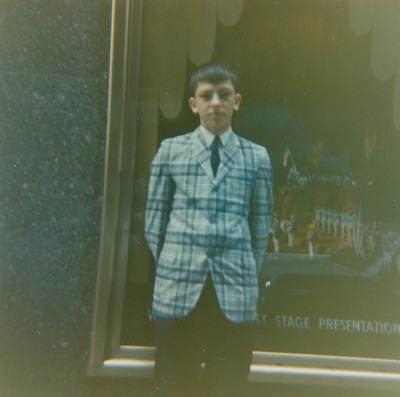
Via Sean Howe’s invaluable Marvel tumblr, this photo of future Marvel editor in chief Jim Shooter at age 14. At that age he sent a spec script to DC editor Mort Weisinger and was hired to write the Legion of Superheroes at that age. While the world of superhero comics was not quite as harsh as it is now…it was still probably no place for a boy, as Howe writes in MARVEL: THE UNTOLD STORY:
Unfortunately, praise was limited to the occasional article in the Pittsburgh newspaper or segment on the local TV news. “My father probably said four or five words to me the whole time I was growing up,” said Shooter. “One of the greatest men to ever walk the earth … but not at connecting with people. He made no comment whatsoever.” And Weisinger didn’t just withhold praise—he cruelly berated his teenage employee, calling from New York every Thursday night, following the weekly Batman television broadcast, with a litany of complaints: It’s not on time. It’s over the page limit. How the hell can we get a cover out of this? Why can’t you write like you used to? He referred to Shooter as his “charity case.” “He caused a kind of pathological fear of telephones in me,” Shooter once told an interviewer. “I felt more and more inadequate … and my last chance to be a kid was slipping by.”
Holding down an adult job—and, at six feet seven inches, now towering above his classmates—scarcely anything about him, save a serious case of acne, marked him as a teenager. He tried to fit it all in, to “get good grades so I could nail down a scholarship, and have a little fun, like football games, dances, parties and stuff. But it was too much, and it all suffered.” He missed sixty days of his senior year of high school, his grades fell, and his productivity for Weisinger decreased.
That’s kind of f*cked up.
Along the same lines, future DC president Paul Levitz was hired, at a later period, at the age of 16 to assist at the DC offices by Joe Orlando. While funny books weren’t the serious business they were to become, one can only imagine the developmental crucible that allowed both these men to eventually run the two biggest superhero comic companies…and come to think of it hiring teenaged boys to work in the comics just has this weird vibe to it.
Blog: PW -The Beat (Login to Add to MyJacketFlap)
JacketFlap tags: News, Comics, DC, Culture, Superman, Joe Shuster, Jerry Siegel, DC Comics, Karen Green, Paul Levitz, Larry Tye, Jim Shooter, Top Comics, Center for Jewish History, Danny Fingeroth, David Weiss, Harry Donenfeld, Jenette Kahn, Mort Weisinger, Nicky Wheeler-Nicholson Brown, Samuel Norich, Superman's 75th Anniversary, Add a tag
TweetThe Center for Jewish History hosted a celebration of the 2013 75th birthday of the seminal superhero Superman on January 27th with co-sponsorship from Columbia University Library. Though Superman’s cover-date advent in comics occurred in June of 1938, celebrations are gearing up early to take a look back at the Kryptonian’s origins and the impact [...]
Blog: PW -The Beat (Login to Add to MyJacketFlap)
JacketFlap tags: First Second, Pope, Nerdlebrities, Paul Levitz, Add a tag
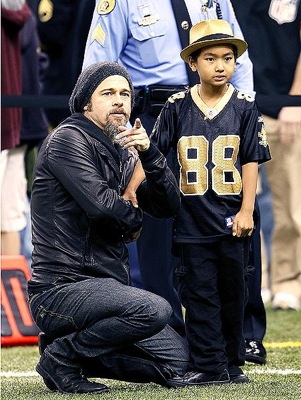
This is from the Enquirer so salt and all that, but apparently Maddox Pitt-Jolie, adapted son of Angelina Jolie and Brad Pitt, is dying to be an action star, so they are grooming him to play the lead in the movie adaptation of Paul Pope’s upcoming BATTLING BOY comic — which PItt’s production company has optioned.
According to the insider, Angelina is pushing hard to get Maddox the lead role in “Battling Boy,” a science fiction epic being produced by Brad’s Plan B production company.
Based on a graphic novel, “Battling Boy” is about the young son of a god who leaves his immortal mountaintop home to fight monsters.
Right. We’ve often posited on this site that Maddox will indeed grow up to be “The One,” but a spin as a kid actor might be too time consuming.
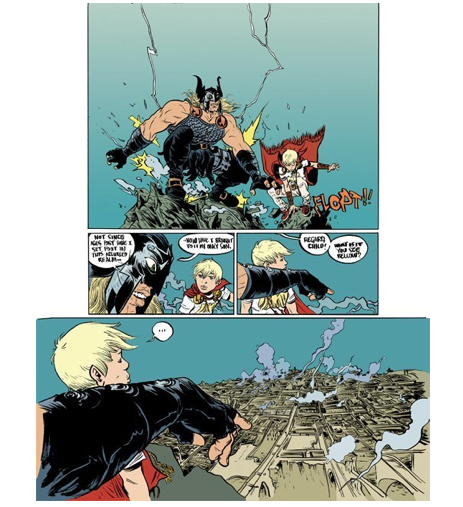
What about Battling Boy the comic? It’s been in the works a while but is almost complete, we hear. Colorist Hilary Sycamore posted a page or two of the colors on her website. Can’t wait.
UPDATE: Paul Pope hopped on Twitter to set the record straight:
I am here to tell you officially it is not true.
Too bad!
Blog: Galley Cat (Mediabistro) (Login to Add to MyJacketFlap)
JacketFlap tags: Joe Hill, Darwyn Cooke, Paul Levitz, Karl Kerschl, Comicbookland, Add a tag
 IDW swept the best writer and best writer/artist category at the 2011 Eisner Awards at Comic-Con International in San Diego this weekend. Follow the links below for free samples of books by some of the winners.
IDW swept the best writer and best writer/artist category at the 2011 Eisner Awards at Comic-Con International in San Diego this weekend. Follow the links below for free samples of books by some of the winners.
Joe Hill won Best Writer for Locke & Key and Darwyn Cooke won Best Writer/Artist for Richard Stark’s Parker: The Outfit (IDW). In addition, 75 Years of DC Comics: The Art of Modern Mythmaking by Paul Levitz won Best Comics-Related Book and Abominable Charles Christopher by Karl Kerschl won the Best Digital Comic award.
Here’s more about the ceremony: “[The awards] ended on an unusual note Friday night with the Best Graphic Album-New category going to two winners: Jim McCann and Janet Lee‘s Return of the Dapper Men (published by Archaia) and Daniel Clowes‘s Wilson [PDF preview] (published by Drawn & Quarterly).”
New Career Opportunities Daily: The best jobs in media.
Add a CommentBlog: PW -The Beat (Login to Add to MyJacketFlap)
JacketFlap tags: Neil Gaiman, Events, Paul Levitz, Add a tag
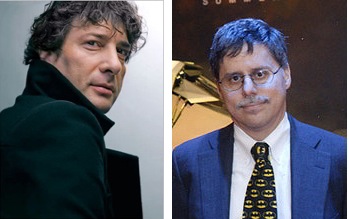
Another one we’d love to attend.
Author, graphic novelist, and screenwriter Neil Gaiman (Sandman, American Gods, Coraline, The Graveyard Book) has been described by the Dictionary of Literary Biography as “one of the top ten living post-modern writers.” Join Paul Levitz, former publisher of DC Comics and lecturer at Columbia University’s Center for American Studies as he talks with Gaiman about his life and his writing.
Presented by the Institute for Israel & Jewish Studies and the Center for American Studies, ColumbiaUniversity.
Seriously, you people need to start taking your iphones and recording this stuff, kamikaze style.
Blog: PW -The Beat (Login to Add to MyJacketFlap)
JacketFlap tags: Paul Levitz, Po, Art, Add a tag

From the Adhouse THB Comics From Mars Issue 2 special edition, now available in the UK only from FPI UK.









































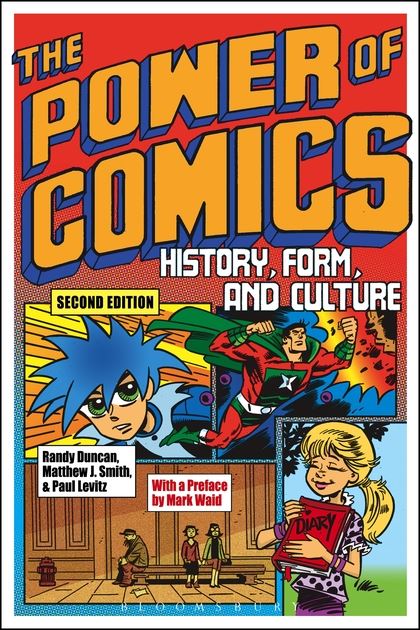
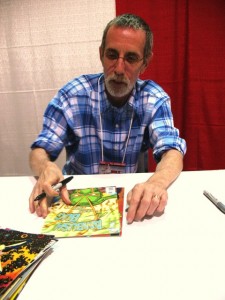
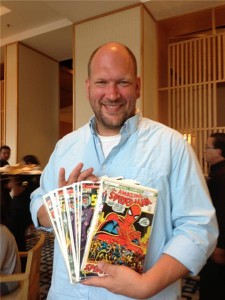
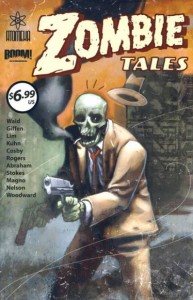
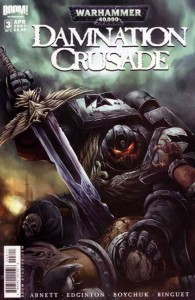

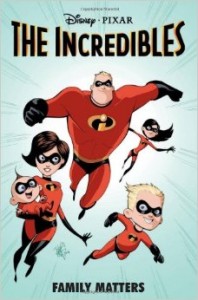
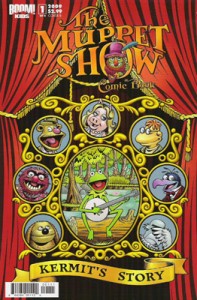

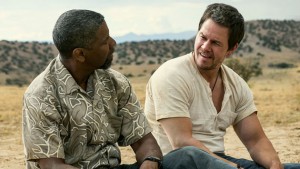


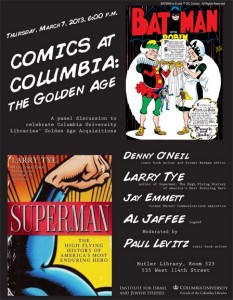
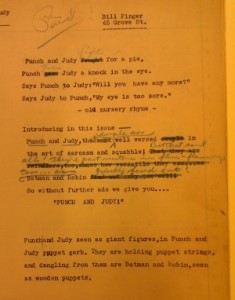
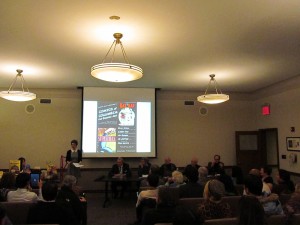
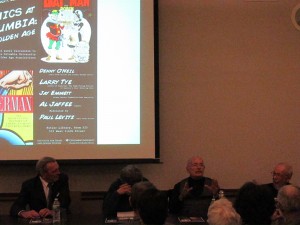
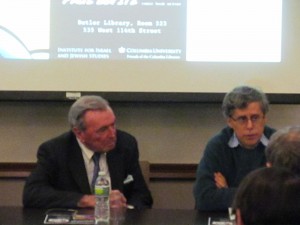
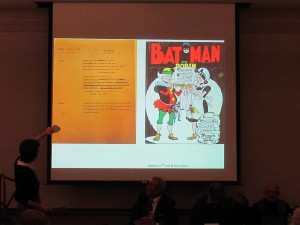

The first real graphic novel would have to be the “Four Immigrants Manga” by Henry Kiyama, released in 1931. Eisner and the rest followed.
Matt Baker and Arnold Drake did a 126-page, digest-sized graphic novel in 1950: “It Rhymes With Lust.” The publisher, St. John, called it a “picture novel.” Its competition, presumably, was the “lurid” paperbacks of the time.
http://www.comics.org/issue/317082/
The first volume of Tintin came out in 1930. Just saying… lots of early examples. But Eisner did get the ball rolling again and this time it worked.